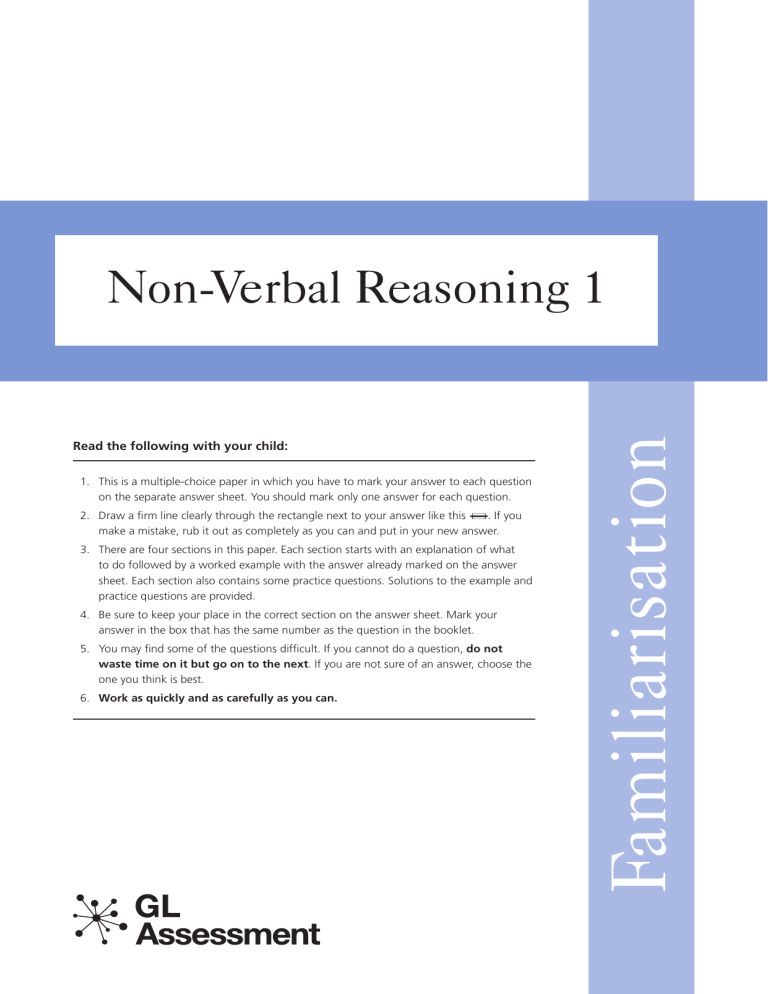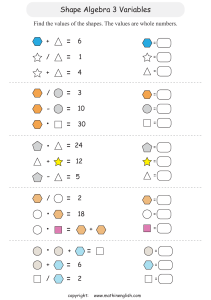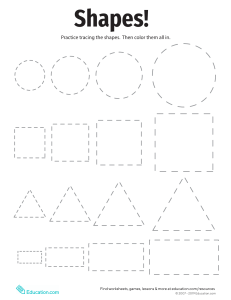
Read the following with your child: 1. This is a multiple-choice paper in which you have to mark your answer to each question on the separate answer sheet. You should mark only one answer for each question. 2. Draw a firm line clearly through the rectangle next to your answer like this * —. If you make a mistake, rub it out as completely as you can and put in your new answer. 3. There are four sections in this paper. Each section starts with an explanation of what to do followed by a worked example with the answer already marked on the answer sheet. Each section also contains some practice questions. Solutions to the example and practice questions are provided. 4. Be sure to keep your place in the correct section on the answer sheet. Mark your answer in the box that has the same number as the question in the booklet. 5. You may find some of the questions difficult. If you cannot do a question, do not waste time on it but go on to the next. If you are not sure of an answer, choose the one you think is best. 6. Work as quickly and as carefully as you can. Familiarisation Non-Verbal Reasoning 1 Page 2 Section 1 To the left in the example below there are five squares arranged in order. One of these squares has been left empty. One of the five squares on the right should take the place of the empty square and its letter has been marked on your answer sheet. Example a A b B c C d D e E Answer: B As you move through the series, the dot acquires an extra ring around it, increasing the overall size of the circle each time. The central dot is present in each cell. Now do the two practice questions below. P1 A B C D E This series has two rules: firstly, an arrow is added each time and, secondly, the direction of the arrows alternates, pointing downwards then upwards etc. Therefore, the missing square should have five arrows pointing downwards, as in answer option C. P2 a A b B c C d D e E In this series, the image changes across every other square so the pattern for 1, 3 and 5 is independent from squares 2 and 4. We can see that the pattern for 2 and 4 remains the same: the five-sided shape doesn’t change. The pattern for 1, 3 and 5 shows that the six-sided shape is always positioned the same way but the direction of the diagonal lines alternates. In square 5 they will be slanting right, as in answer option A. Page 3 Please go on to the next page >>> 1 A B C D E A B C D E A B C D E A B C D E A B C D E 2 3 4 5 Page 4 Please go on to the next page >>> 6 A B C D E A B C D E A B C D E A B C D E A B C D E 7 8 9 10 Page 5 Please go on to the next page >>> 11 A B C D E A B C D E A B C D E A B C D E A B C D E 12 13 14 15 Page 6 Please go on to the next page >>> 16 A B C D E A B C D E A B C D E A B C D E A B C D E 17 18 19 20 Page 7 Please go on to the next page >>> Page 8 Please go on to the next page >>> Section 2 On the left of the example below are two shapes with an arrow between them. Decide how the second is related to the first. After these there is a third shape, then an arrow and then five more shapes. Decide which of the five shapes goes with the third one to make a pair like the two on the left. Its letter has been marked on your answer sheet. Example a A b B c C d D e E Answer: B The shape rotates 180° but doesn’t change size. Now do the two practice questions below. P1 A B C D E In the two shapes on the left, we can see that the shape changes from a shield to a square but the size remains the same and so does the line style. This means that the dashed shield will change to a dashed square of the same size. This makes C the correct answer. P2 A B C D E In the two shapes on the left, we can see that the shapes stay the same but there is a reversal of shading. The third shape is a small white ‘keyhole’ inside a black six-sided figure so shape four must be the same but with reverse shading. Therefore, A is the correct answer. Page 9 Please go on to the next page >>> 21 A B C D E A B C D E A B C D E A B C D E A B C D E 22 23 24 25 Page 10 Please go on to the next page >>> 26 A B C D E A B C D E A B C D E A B C D E A B C D E 27 28 29 30 Page 11 Please go on to the next page >>> 31 A B C D E A B C D E A B C D E A B C D E A B C D E 32 33 34 35 Page 12 Please go on to the next page >>> 36 A B C D E A B C D E A B C D E A B C D E A B C D E 37 38 39 40 Page 13 Please go on to the next page >>> Page 14 Please go on to the next page >>> Section 3 On the left of the example below there are two figures that are alike. On the right there are five more figures: one of these is most like the two figures on the left and its letter has been marked on your answer sheet. Example a A b B c C d D e E Answer: C The two shapes on the left are alike in having four sides. They are not identical (the dimensions of the sides vary) but what they share in common is having four sides. Now do the two practice questions below. P1 A B C D E The two figures on the left both contain a small black circle. Only one of the five figures on the right, option B, also contains a small black circle, so this is the correct answer. P2 A B C D E The two figures on the left have an arrow with an arrowhead which is an unshaded equilateral triangle (a triangle in which all three sides are equal). Only answer option C has an unshaded equilateral triangle as the arrowhead. The size of the arrowhead is irrelevant and so is the direction in which the arrow is pointing. Page 15 Please go on to the next page >>> 41 A B C D E A B C D E A B C D E A B C D E A B C D E 42 43 44 45 Page 16 Please go on to the next page >>> 46 A B C D E A B C D E A B C D E A B C D E A B C D E 47 48 49 50 Page 17 Please go on to the next page >>> 51 A B C D E A B C D E A B C D E A B C D E A B C D E 52 53 54 55 Page 18 Please go on to the next page >>> 56 A B C D E A B C D E A B C D E A B C D E A B C D E 57 58 59 60 Page 19 Please go on to the next page >>> Section 4 To answer these questions you have to work out a code. In the boxes on the left are shapes and the code letters that go with them. The top letters mean something different to the bottom ones. You must decide how the letters go with the shapes. Then find the correct code for the test shape from the set of five codes on the right and mark its letter on your answer sheet. The examples below have been done for you and the answers marked on the answer sheet. Example 1 TEST SHAPE A B C D E Answer: B In the example above, both squares have a Y at the top but the circle has an X, so the top code must be for shape. Both white shapes have an S at the bottom, but the shaded shape has a T, so the bottom code must be for shading. The test shape is a shaded circle so its code letters must be X for circle and T for shading, and B has been marked on the answer sheet. Now look at the second example: Example 2 TEST SHAPE A B C D E Answer: A Both circles have an M at the top but the triangle has an N, so the top code must be for shape. The bottom code letter is different for each shape so G, H and I must be the codes for no dot, one dot and two dots. The test shape is a triangle with no dots so its code letters must be N for triangle and G for no dots, and A has been marked on the answer sheet. Now do the practice question below. Remember there is a new code for each question. Page 20 Please go on to the next page >>> P1 A B C D E Both six-sided shapes have an R at the top and both four-sided shapes have an S, so the top code must be for the shape. The bottom codes show that both shapes with diagonal lines have an F, the unshaded shape a G and the shaded shape an H, so the bottom codes must be for the shading. The test shape is six-sided and unshaded so its code letters must be R for shape and G for shading, so E is the correct answer. Page 21 Please go on to the next page >>> 61 A B C D E 62 D D E D D E L E L M M L M M M L A B C D E 63 C D C D C D D C P Q R R Q P Q R A B C D E 64 C C D C C D D D R S T S T R T S A B C D E 65 Page 22 Q R S T T Q S Q T H I H J H J J I I A B C D E Please go on to the next page >>> 66 J K J K J K K J X Y Z Y Y Z X X A B C D E 67 C D C D D C D C D P Q R P P Q Q P R A B C D E 68 F G F G F G F G P Q R P Q R P Q A B C D E 69 D E F D E F E D D R S R S S S R S R A B C D E 70 Page 23 T V T U T V V U U P Q R S S S R Q R A B C D E Please go on to the next page >>> 71 P Q R P Q R P Q P W X Y Z W Z Y Y X A B C D E 72 T U V T U V V U T G H I H G G H I I A B C D E 73 H I J K I J H I J T U V U T U U V T A B C D E 74 A B A A A B A B W X Y X Y W W Y A B C D E 75 Page 24 X Y X Z Y Z Y Z X J K L J L L J K K A B C D E Please go on to the next page >>> 76 A B C D D B C C A W X X W X W X W X A B C D E 77 D E F D F E D F B B C C B C B C A B C D E 78 E F G E F E F G E X Y Z Y X Z Z Y X A B C D E 79 D E E D D E D E D N N O P N O E P O A B C D E 80 Page 25 C D D E C E D E C W X W X X W X X W A B C D E END OF FAMILIARISATION PAPER Copyright © GL Assessment, 2017. All rights reserved, including translation. No part of this publication may be reproduced or transmitted in any form or by any means, electronic or mechanical, recording or duplication in any information storage and retrieval system, without permission in writing from the publishers. Published by GL Assessment, 1st Floor, Vantage London, Great West Road, Brentford TW8 9AG. Printed in Great Britain. Code 6853 929 1(07.17) PF


